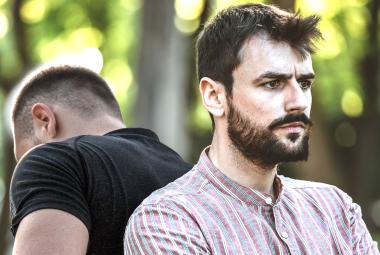I write this article from RAMAT RACHEL, a kibbutz our BASE/KHOUSE tour participants visited as part of their tour of the Holy Land during the month of May. I write this on the second Sunday of the month of May, the day we refer to as Mother's Day. I cannot help but think of my wife Ruth and our daughter Rachel as I type this article. Both my wife and I had passed our fortieth birthdays before Rachel arrived and she has added sunshine to our lives every day since her birth. Thank you for permitting me this personal reminisce and reflection − it has nothing to do with the article.
Last month we introduced our gracious readers to the practice of relying on questions during meaningful conversations. Jesus modeled focused questioning for us in Luke 24. Through questions, we can engage in active listening and thereby understand “the need of the moment that we may be able to give grace” to the listener. Luke records Jesus asking three questions of his walking companions before He ever said much of anything else. Rephrasing His words, He asked: “Why are you sad?”, “What things occupy your thoughts?” and “Should these things be such a surprise to you?”
These questions and the resulting conversation illustrate a deeply personal interaction among three people. In this article, I will develop a framework for relying on questions when the conversation is more confrontational and I will do this from the perspective of the courtroom. When introducing testimony in the evidentiary record, advocates rely on two types of questions: direct questioning and cross-examination. We do the same thing − although less formerly and certainly less deliberately – in our conversations. The following paragraph will compare the two.
Direct questioning generally involves open-ended questions which allow the respondent to answer in a narrative form. While the witness is no doubt prepared for the line of questioning, the testimony is most effective when delivered naturally and genuinely. The opposing counsel is likely to object to any query deemed a leading question. A leading question is one that implies the answer. It is an entirely different matter in the courtroom to ask “What color was the traffic light?” and “Was the traffic light red?” The former does not suggest the answer the questioner is looking for while the latter makes it clear what the questioner expects to hear. When Jesus asked “Why are you sad?”, He gave broad latitude and space to the respondent in how much to say and how to say it. Cross-examination is completely different when done effectively and properly. First, cross-examination addresses testimony already entered in the evidentiary record. And the skilled practitioner relies on leading questions to get the answer needed. “Isn't it true that the light was red?” After an affirmative reply, the follow-up question might be, “Isn't it true in this state that a red light requires the driver to stop the vehicle?” “Yes.” “Isn't it true in every neighboring state that a red light requires the driver to stop the vehicle?” The “yes” response gets quieter as the eyes avert downward and the point is made. This hypothetical example hardly uncovers earth-shattering truth and below I will turn to a more recent example to better illustrate the use of cross-examination to complete the evidentiary record and to drill down on the facts contained therein. And effective questioning like this relies on the oft-quoted phrase “Never ask a question to which you don't already know the answer.”
Before I do so, I want to use a couple of familiar vignettes to illustrate what this paragraph is addressing. In the movie A Few Good Men, Tom Cruise's character is cross-examining Jack Nicholson's character when he asks the question, “Did you order the Code Red?” As the prosecuting attorney, Cruise succeeded in baiting Jack Nicholson to enter testimony while under oath which substantiated the claims of the charges of the prosecution. While many of us long for the “Code Red” moment where we ingeniously maneuver our antagonist to contradict his prior testimony and compromise his presupposed credibility, these moments are rare in the courtroom and frankly even rarer in a conversation. Instead of seeing cross-examination as a “gotcha” moment, it is better understood as an effort to get a more complete record where shallow statements are developed, and unclear testimony is refocused. Effective questioning resists “gotcha moments.”
Let's consider a second example. At the 2018 Spyglass Conference, I introduced my presentation using one of the most famous zingers in American politics. The Los Angeles Times described it as “the biggest VP debate moment in history.” During the 1988 American Vice Presidential debates, Candidate Lloyd Bentsen was ready for Candidate Dan Quayle's anticipated comparison of his qualifications to those of Jack Kennedy. After Quayle invoked the record of Kennedy, Bentsen responded in measured and theatrical phrasing with, “I served with Jack Kennedy. I knew Jack Kennedy. Jack Kennedy was a friend of mine. Senator, you're no Jack Kennedy.” BAM! We can call this the zinger heard around the world which combined a clever comeback with devastating delivery. And yet the ticket of Bush/Quayle went on to a decisive victory over Dukakis/Bentsen in that 1988 election. This witticism did not result in a victory.
Finding the truth and understanding the perspective of another is not achieved by Code Red moments or spontaneous (or even rehearsed) zingers. Instead, a well-phrased and well-informed question can aid in the pursuit of truth where consensus is elusive. Let's look at another example.
Our tour visited Masada last week and the story of the Roman siege in 73 A.D. is well documented and familiar to many. The popular narrative of what happened to the some 1,000 Jews living in Masada goes something like this. The Roman Army built a siege ramp (still visible today) in order to be able to break through walls around Masada and on the night before they would have been able to do so, the decision was made to kill 960 people living there. Each father killed his family members. Then the men drew lots to kill each one in turn with the final man taking his own life. Lazard Ben Yair rallied the residents with these words: “Since we long ago resolved never to be servants to the Romans, nor to any other than to God Himself, Who alone is the true and just Lord of mankind, the time is now come that obliges us to make that resolution true in practice ... We were the very first that revolted, and we are the last to fight against them; and I cannot but esteem it as a favor that God has granted us, that it is still in our power to die bravely, and in a state of freedom.”
I have no intention in this article of defending or contesting this narrative and instead rely on it solely to illustrate precise “cross-examination” of this story. Consider the following questions fashioned after the cross-examination style described above:
- Isn't it true that the remains of fewer than thirty bodies were found? If so, how do you explain the missing remains of the 900-plus other victims?
- Isn't it true that Josephus only includes one palace in his writings? If so, how do you account for the presence of 2 palaces found by archaeologists?
- Isn't it true that the Torah forbids murder and suicide? If so, how do you account for these devout Jewish believers violating the clear commandments of G-d?
- Isn't it true that the history of the Jewish people is one of slavery? If so, how do you account for this deviation of behavior from a history of enduring slavery and waiting on G-d for deliverance?
Well, you get the idea. Instead of “yeah, but what about” digs, these type of questions promote discussion. Each one fosters scholarship. The responses to the questions will increase the likelihood of finding the true and complete narrative. Each one is respectful. Gotcha moments and witty zingers have no place in this sort of questioning. Furthermore, any Ad Hominem attacks or Straw Man arguments are avoided. But these will be part of another topic for another article.
As an exercise, at your next family meal or friendly gathering, have a conversation where you begin with three questions. It can be about personal matters or it can be a profound one. I am eager to hear about the results of this homework assignment and I hope to use them in an upcoming Personal Update article.





